Church on the Dnister: A Unique Monument of Sacred Art in Danger of Destruction

Considering the long period which Ukraine’s Bukovyna was ruled by foreign empires, any evidence of its history as a part of Great Ukraine is worth its weight in gold. Even more so when chronicles attest to its history during the times of Halych-Volhynian Rus’. Our story centers on the ancient city of Vasyliv, nowadays a village in Zastavniv district, Chernivetsiy region. Vasyliv claims its origins as far back as the Pecherska Lavra and Saint Sophia Cathedral. However, due to neglect by state officials, this unique archeological and cultural site is in danger of being destroyed. While churches of the nation’s capital are defended by the whole country, the fate of other sacred historical sites, just as important but situated in provinces, come to resemble the fate of residents of that locale, remote and seemingly forgotten by bustling centers of activity.
“When Chernivtsi was just a village, the city of Vasyliv already boasted 12 churches.”
”Vasyliv of the famed chronicles,” as the one and a half thousand locals like to call their famous village, is no different in appearance from other settlements in Bukovyna: lopsided fences, pot-holed roads, abandoned houses, and general dilapidation attest to the fact that builders of communism did not bypass this picturesque nook. Only the massive stone crosses scattered like mushrooms after rainfall on the tops of clay-hilled promontories to the south of the village hint at the past glory of one of Halychynian Rus’s main ports, where once 20,000 to 40,000 residents dwelled at the height of the town’s flourishing.
Standing alone, in pairs or groups, large or miniature, these crosses are adorned with pagan ornaments and bear anonymous Cyrillic inscriptions. They endure through rain, snow and heat, standing as dumb witnesses to an ancient epoch. At times, when major construction occurs on the sites of ancient settlements or feudal castles, evidencing, as expressed in the modern idiom, a “trans-European corridor” of Old Rus’, a special thin brick called plinf is unearthed, the building material of Old Rus’ churches. Still today, peasants dig up bones under gravestones in their gardens.
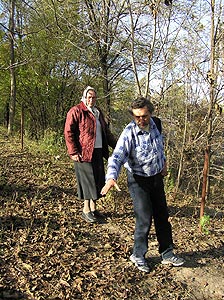 Stories about Vasyliv usually begin with the proclamation, “When Chernivtsi was just a village, the city of Vasyliv, situated on the right bank of the Dnister, opposite where the Seret flows into the Dnister, counted 12 to 70 churches in its environ.” Thus begins the excursion speech of Maria Smuk, a curator of the community-run village museum and history teacher at the local school. “Some say that this village was actually named “Veseliv” (“the happy one”), Smuk jokes, “because of the good nature of its residents, but that was a long time ago…”
Stories about Vasyliv usually begin with the proclamation, “When Chernivtsi was just a village, the city of Vasyliv, situated on the right bank of the Dnister, opposite where the Seret flows into the Dnister, counted 12 to 70 churches in its environ.” Thus begins the excursion speech of Maria Smuk, a curator of the community-run village museum and history teacher at the local school. “Some say that this village was actually named “Veseliv” (“the happy one”), Smuk jokes, “because of the good nature of its residents, but that was a long time ago…”
“The first written mention of Vasyliv dates from 1230. Retreating from Halych, the Hungarian King Bela ‘made his way to Vasyliv,’ where, finding a suitable pier, ‘he crossed the Dnister and sailed to the river Prut,’ according to the Halych-Volhynian chronicler.”
“The site of the city square where various relics of the ancient city are found is substantially larger than that of the modern village square. There are still signs of the old moat and wooden walls which encircled the city. Within this area in the early days of the city, remnants of a wooden church from the 12th and 13th centuries were uncovered. To the south, not far from the White Stone Church in the area of Khom, lies the site of another ancient settlement belonging to a feudal castle of the same period, fortified by ramparts and palisades,” continues Smuk.
“It is possible that the future emperor of Bizantium, Andronik Komnin, spent his years of exile in Vasyliv. Also, some residents of Vasyliv are convinced that Vasylivian monks, when rendered homeless by Mogol invasions, moved from the banks of the Dnister to the shores of the Prut, and founded Chernivtsi.”
A rarity in every foundation
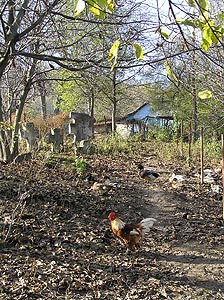 After climbing the steep ascent, we are at the top of the hill in the southern part of the settlement where peasants have been digging clay for construction works for many years. Remnants can be seen of the foundation of the 12th-century White Stone Church, walls of stone sarcophaguses, and lopsided crosses hard by where the rough surface of the mountain is plowed and hens and geese are wandering.
After climbing the steep ascent, we are at the top of the hill in the southern part of the settlement where peasants have been digging clay for construction works for many years. Remnants can be seen of the foundation of the 12th-century White Stone Church, walls of stone sarcophaguses, and lopsided crosses hard by where the rough surface of the mountain is plowed and hens and geese are wandering.
“The ancient remains,” says Smut, “bring to mind old tales about small children buried in the foundation of the church and the architect’s wife embedded in the wall. People say that during the digging up of the foundation, the skeleton of a woman was actually found embedded there. More likely it was buried in the sarcophagus.”
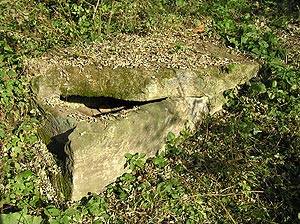 The 12th-century White Stone Church is considering in Bukovyna only second in importance to the famed Khotyn fortress, yet obviously it has fallen upon harder times. If work continues at the open-cast clay mine, which was created by local craftsman from a hill containing the remnants of the Old Rus’ church and cemetery, the foundations of the unique building will disappear forever. Thus, if illegal clay mining is not stopped immediately, it is quite probable that many rare artifacts will find their permanent home not in a museum collection, but in the foundations and walls of business persons from Vasyliv.
The 12th-century White Stone Church is considering in Bukovyna only second in importance to the famed Khotyn fortress, yet obviously it has fallen upon harder times. If work continues at the open-cast clay mine, which was created by local craftsman from a hill containing the remnants of the Old Rus’ church and cemetery, the foundations of the unique building will disappear forever. Thus, if illegal clay mining is not stopped immediately, it is quite probable that many rare artifacts will find their permanent home not in a museum collection, but in the foundations and walls of business persons from Vasyliv.
In regards to this, a session of the Chernivtsi Regional Council examined Deputy Serhii Dobrozhany’s petition concerning the improper treatment of archeological and architectural monuments by the residents of some villages in Zastavniv. At the end of last year the Council approved the decision to direct this issue to the head of Zastavniv Regional Department of the Ukrainian Ministry of Internal Affairs in Chernivtsi region; nevertheless, concern persists over the fate of the monument. Whether law enforcement officers can resolve the issue or not will only be seen if and when systematic archeological digs begin to take place.
“…Havryl’s son and his wife Odokia were cut to pieces . . .”
“Be careful - do not approach the church altar.” Smut’s words suddenly stop the flow of my thoughts.
“The liturgy was celebrated here for more than 200 years. Remnants of the White Stone Church in Vasyliv evidence its high status. Such buildings with a height of 32 to 34 meters were built only for metropolitans or their deputies, and only those of the princely and boyar classes were buried within, in stone sarcophagi. When we carry out cleaning duties here, only boys are allowed to enter the altar area; girls clean other sections of the church.” Even though it is difficult to distinguish the altar from the rest of the church at first glance, we heed Smuk’s warnings and stop at the designated place.
She continues the excursion, pointing out that the exterior of the Vasyliv Church is modeled on the Halychynian Pontelimon Church of Old Rus’ times, and that probably Artil of Byzantium was its architect. Its destruction began soon after construction, first by Mongols in the 13th Century and then Turkish janissaries from Kamianets’ in the 17th Century. After these latter attacks, the church was never restored.
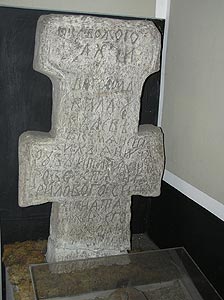 “An inscription on a stone cross provides witness to those times long past: ’In the year of our Lord 1698 a massacre occurred in Val’va, carried out by Kamianets’ janissaries, who murdered Havryil’s son, Ihnat, and his wife Odokia. Remember, O God, the souls of your servants,’ The stone cross is preserved today in the collections of the Chernivtsi Folklore Museum. The preserved skull of poor Ihnat who was killed by a Muslim saber also reminds us of that,” says Smuk.
“An inscription on a stone cross provides witness to those times long past: ’In the year of our Lord 1698 a massacre occurred in Val’va, carried out by Kamianets’ janissaries, who murdered Havryil’s son, Ihnat, and his wife Odokia. Remember, O God, the souls of your servants,’ The stone cross is preserved today in the collections of the Chernivtsi Folklore Museum. The preserved skull of poor Ihnat who was killed by a Muslim saber also reminds us of that,” says Smuk.
Incidentally, due to lack of funds, the museum can not display the relics from Vasyliv; they only gather dust is the museums’s reserve rooms.
The church was finally dismantled in the 18th Century by the citizens of Vasyliv. The altar was moved by oxen to the new church over the course of twelve days. Stone remnants of the church were sold as material for construction in Dobrynivtsi.
Water washes away more bones after each heavy rainfall
The unusual group of visitors attracts lively interest from the local residents whose houses and gardens lie nearby the church. Reassured that no one has come to take away their lands, they begin to retell tales of the place:
“O, God! There were so many skulls. There were piles of them in the houses when the head of the Bukovyna Archeological School was conducting digs where the White Stone Church used to be,” recalls Odarka Hyrvul. Archeologists also found some fragments of material from Old Rus’ times, such as an altar cross, and chiltse, a woman’s adornment.
“My Shtefan along with other men who were paid by Boris Onysymovych dug up many such things,” continues Hryvul. “Since they were young at that time, sometimes they made jokes. My uncle, for example, one day laid down as if dead in a recently dug up stone trough.”
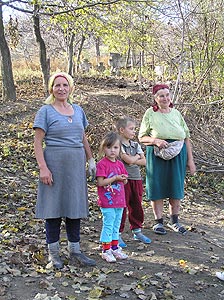 Clearly this lady does not suspect that the object of the joke was a stone sarcophagus at least 800 years old, and that its owner was far from the least important person in Halychynian Rus,’ supposedly a relative of the Prince of Terebovlia. The mark of the mysterious square labyrinth, which is called by experts the “sign of Babylon,” adorns his sarcophagus which has been preserved till today in the Chernivtsi Folklore Museum. No expert is present to recount for this lady how reconstruction of the skulls according to Herasymov’s method shows their almost complete identification with the ones of today’s citizens of Zastavniv. Thus, all peasants of the village, including Hryvul herself, are direct heirs of Rus’.
Clearly this lady does not suspect that the object of the joke was a stone sarcophagus at least 800 years old, and that its owner was far from the least important person in Halychynian Rus,’ supposedly a relative of the Prince of Terebovlia. The mark of the mysterious square labyrinth, which is called by experts the “sign of Babylon,” adorns his sarcophagus which has been preserved till today in the Chernivtsi Folklore Museum. No expert is present to recount for this lady how reconstruction of the skulls according to Herasymov’s method shows their almost complete identification with the ones of today’s citizens of Zastavniv. Thus, all peasants of the village, including Hryvul herself, are direct heirs of Rus’.
Indeed, there are many human bones. They are not only in stone sarcophaguses, fragments of which can be seen all over the grounds the former church. Even against the wall of the barn situated on the opposite side of the road separating the church from the rest of the village, one can see a skull, spine, and some other bones. Who knows what mysteries would be learned if archeological digs were conducted?
“It is good that it has not been raining for a long time. After every shower water washes away new bones on this road we are walking on,” observes the museum curator.
“Last year, together with our priest, we gathered remnants of the dead from Old Rus’ times. Among them were bones of women and children. Together with the remnants of the coffin and elements of adornments we reburied them according to church canonical rules. Clearly, we will have to ask Father about the possibility of new reburial ceremonies.
Those Old Rus’ burials were found when gas pipeline was being laid on one of the central streets of the village. Even though the remnants were buried according to Christian tradition, experts began to worry. It is prohibited to conduct any construction works on land containing ancient relics. It is obvious that it was necessary to build the gas pipeline above the ground rather than dig trenches. In fact, villagers did not even allow archaeologists to sufficiently excavate and study the remnants found because they were scared of revenge from the dead. Who knows to what depths in human consciousness lies the fear of punishment, such as that of 1230, “sent by God” upon the Hungarians about whom it is written, “and the angel killed them.” A 700-year-old description of the plague which struck the army of the Hungarian King Bela, is quite remarkable: “They were dying like that: some were dropping away like the loose sole of a shoe, others were falling off their horses, still others died gathering around the fire and raising meat to their mouths. They died of many illnesses, and in the end, rivers sent from heaven drowned those remaining.”
“Unique artifacts were loaded onto carts and thrown on the stairs of the club”
To save these important and vast stores of history, extraordinary action is required because even the intense efforts of local enthusiasts like Mariia Smuk do not help. There will be nothing left to save if everything continues as it is going. The first step towards these changes should be designating a certain areas of Vasyliv as an archeological preserve of national significance and clearly defining its perimeters. Only 5 % of the territory of this chronicled city has been examined by archaeologists to date. After this, the government would need to provided funds for archeological excavation and radiocarbon analysis for artifacts found in sarcophagi. Who knows what mysteries may be hidden in these burials under the blocks of the White Stone Church. Unique discoveries could fill up the museum of historic Vasyliv, and the ancient castle on Mount Khom, the rock monastery, and the White Stone Church as well as other churches could attract thousands of lovers of the exotic.
The fact that the Chernivtsi Regional Council approved the “Program for preserving objects of cultural heritage of Chernivtsi region, 2007-2010,” proves that this problematic issue can be resolved. According to this plan, 21 million UAH should be set aside for the required activities. However, considering how approved cultural programs are financed and taking into account that this program is only number 13 in the list of programs which were approved by the regional council for functioning and financing in 2007, the chances that this historical area will be saved is decreasing every year.
In Vasyliv, there is experience of not preserving but rather destroying ancient heritage. In 1991, the village history museum, founded in 1976, was destroyed. Leaders of the local collective farm decided that a condenser workshop on the museum premises would be more useful than some old broken pots. Gathered by a few generations of scientists, among them Raymond Frederik Kaindel and Borys Tymoschuk, these unique artifacts were loaded onto carts and dumped on the stairs of the village club. These days, unfortunately, one can hear it said that the village’s past is hindering its future. If not for this ancient past, they say, the village could have long since been the site of a brick factory or a tourist center by the Dnister.
Basically destroyed by the indifference of those in power, this historic site, with careful management and provision of adequate infrastructure, could have been an outstanding tourist attraction in the region. But, unfortunately, not a single voice is declaring rescue for Vasyliv. Ukraine would have such a truly unique site on the tourist map, “fabled Vasyliv,” if the priority placed on tourism in Bukovyna’s development were not just something on paper.









